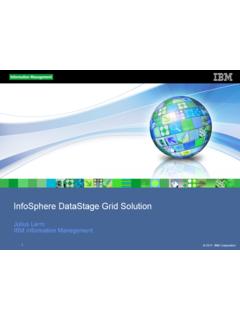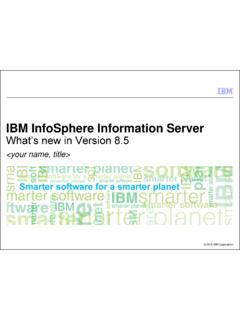Transcription of White Paper: What Is DataStage - Member Portal | …
1 White PaperWhat IsDataStage? White PaperWhat is DataStage ? 2 of 10 All rights paper : what Is DataStage ?Sometimes DataStage is sold to and installed in an organization and its IT support staff are expected to maintain it and to solve DataStage users' problems. In some cases IT support is outsourced and may not become aware of DataStage until it has been installed. Then two questions immediately arise: " what is DataStage ?" and "how do we support DataStage ?". This White paper addresses the first of those questions, from the point of view of the IT support provider. Manuals, web-based resources and instructor-led training are available to help to answer the is actually two separate things. In production (and, of course, in development and test environments) DataStage is just another application on the server, an application which connects to data sources and targets and processes ("transforms") the data as they move through the application.
2 Therefore DataStage is classed as an "ETL tool", the initials standing for extract, transform and load respectively. DataStage "jobs", as they are known, can execute on a single server or on multiple machines in a cluster or grid all applications, DataStage jobs consume resources: CPU, memory, disk space, I/O bandwidth and network bandwidth. DataStage also has a set of Windows-based graphical tools that allow ETL processes to be designed, the metadata associated with them managed, and the ETL processes monitored. These client tools connect to the DataStage server because all of the design information and metadata are stored on the server. On the DataStage server, work is organized into one or more "projects". There are also two DataStage engines, the "server engine" and the "parallel engine". The server engine is located in a directory called DSEngine whose location is recorded in a hidden file called /.
3 Dshome (that is, a hidden file called .dshome in the root directory) and/or as the value of the environment variable DSHOME. (On Windows-based DataStage servers the folder name is Engine, not DSEngine, and its location is recorded in the Windows registry rather than in /.dshome.) White PaperWhat is DataStage ? 3 of 10 All rights The parallel engine is located in a sibling directory called PXEngine whose location is recorded in the environment variable APT_ORCHHOME and/or in the environment variable EnginesThe server engine is the original DataStage engine and, as its name suggests, is restricted to running jobs on the server. The parallel engine results from acquisition of Orchestrate, a parallel execution technology developed by Torrent Systems, in 2003. This technology enables work(and data) to be distributed over multiple logical "processing nodes" whether these are in a single machine or multiple machines in a cluster or grid configuration.
4 It also allows the degree of parallelism to be changed without change to the design of the ArchitectureLet us take a look at the design-time infrastructure. At its simplest, there is a DataStage server and a local area network on which one or more DataStage client machines may be connected. When clients are remote from the server, a wide area network may be used or some form of tunnelling protocol (such as Citrix MetaFrame) may be used 1 DataStage Design-Time ArchitectureDataStageEngineAny source(s)Any target(s)DataStageClients"Repository"Net workAdministratorRepository ManagerDesignerDirectorVersion White PaperWhat is DataStage ? 4 of 10 All rights that the Repository Manager and Version Control clients do not exist in version and later. Different mechanisms exist, which will be discussed to data sources and targets can use many different techniques, primarily direct access (for example directly reading/writing text files), industry-standard protocols such as ODBC, and vendor specific APIs for connecting to databases and packages such as Siebel, SAP, Oracle Financials, Client/Server ConnectivityConnection from a DataStage client to a DataStage server is managed through a mechanism based upon the UNIX remote procedure call mechanism.
5 DataStage uses a proprietary protocol called DataStage RPCwhich consists of an RPC daemon (dsrpcd) listening on TCP port number 31538 for connection requests from DataStage dsrpcd gets involved, the connection request goes through an authentication process. Prior to version , this was the standard operating system authentication based on a supplied user ID and password (an option existed on Windows-based DataStage servers to authenticate using Windows LAN Manager, supplying the same credentials as being used on the DataStage client machine this option was removed for version ). With effect from version authentication is handled by the Information Server through its login and security "Repository"NetworkDataStage RPCdsrpcservicesshared White PaperWhat is DataStage ? 5 of 10 All rights 2 Connecting to DataStage server from DataStage clientEach connection request from a DataStage client asks for connection to the dscs ( DataStage Common Server) service.
6 The dsrpcd (the DataStage RPC daemon) checks its dsrpcservices file to determine whether there is an entry for that service and, if there is, to establish whether the requesting machine's IP address is authorized to request the service. If all is well, then the executable associated with the dscs service (dsapi_server) is Processes and Shared MemoryEach dsapi_server process acts as the "agent" on the DataStage server for its own particular client connection, among other things managing traffic and the inactivity timeout. If the client requests access to the Repository, then the dsapi_server process will fork a child process called dsapi_slave to perform that , therefore, one would expect to see one dsapi_server and one dsapi_slave process for each connected DataStage client. Processes may be viewed with the ps -ef command (UNIX) or with Windows Task DataStage process attaches to a shared memory segment that contains lock tables and various other inter-process communication structures.
7 Further each DataStage process is allocated its own private shared memory segment. At the discretion of the DataStage administrator there may also be shared memory segments for routines written in the DataStage BASIC language and for character maps used for National Language Support (NLS). Shared memory allocation may be viewed using the ipcs command (UNIX) or the shrdump command (Windows). The shrdump command ships with DataStage ; it is not a native Windows ProjectsTalking about the Repository is a little misleading. As noted earlier, DataStage is organized into a number of work areas called "projects". Each project has its own individual local Repository in which its own designs and technical and process metadata are White PaperWhat is DataStage ? 6 of 10 All rights 3 DataStage ProjectsEach project has its own directory on the server, and its local Repository is a separate instance of the database associated with the DataStage server engine.
8 The name of the project and the schema name of the database instance are the same. System tables in the DataStage engine record the existence and location of each of any particular project may be determined through the Administrator client, by selecting that project from the list of available projects. The pathname of the project directory is displayed in the status there are no connected DataStage clients, dsrpcd may be the only DataStage process running on the DataStage server. In practice, however, there are one or two DataStage deadlock daemon (dsdlockd) wakes periodically to check for deadlocks in the DataStage database and, secondarily, to clean up locks held by defunct processes usually improperly disconnected DataStage monitor is a Java application that captures "performance" data (row counts and times) from running DataStage jobs.
9 This runs as a process called "A""Repository"Project"B""Repository" White PaperWhat is DataStage ? 7 of 10 All rights in Version version all of the above still exists, but is layered on top of a set of services called collectively IBM Information Server. Among other things, this stores metadata centrally so that the metadata are accessible to many products, not just DataStage , and exposes a number of services including the metadata delivery service, parallel execution services, connectivity services, administration services and the already-mentioned login/security service. These services are managed through an instance of a WebSphere Application 4 Version and later InfrastructureThe common repository, by default called XMETA, may be installed in DB2 version 9 or later, Oracle version 10g or later, or Microsoft SQL Server 2003 or DataStage server, WebSphere Application server and Information Server may be installed on separate machines, or all on the same machine, or some combination of machines.
10 The main difference noticed by DataStage users when they move to version 8 is that the initial connection request names the Information Server (not the DataStage server) and must specify the port number (default 9080); on successful authentication they DataStageEngineDataStageClients"Reposito ry"NetworkWebSphere App ServerInformation ServerCommon White PaperWhat is DataStage ? 8 of 10 All rights then presented with a list of DataStage server and project combinations being managed by that particular Information ArchitectureNow let us turn our attention to run-time, when DataStage jobs are executing. The concept is a straightforward one; DataStage jobs can run even though there are not clients connected (there is a command line interface (dsjob) for requesting job execution and for performing various other tasks).Figure 5 DataStage at Run TimeHowever, server jobs and parallel jobs execute totally differently.


